The Sapphire R9 280X Toxic Review
by Ryan Smith on October 10, 2013 8:00 AM EST- Posted in
- GPUs
- Radeon
- Sapphire
- Tahiti
- Radeon 200
Overclocking
Our final evaluation criteria is overclocking. And this will be short and sweet, as the 280X Toxic isn’t really designed for end user overclocking in the first place. Without voltage adjustment and already shipping at clockspeeds towards the tail end of the curve for the Tahiti GPU, there was absolutely no GPU overclocking headroom for our sample. It was rock solid at stock, but even 10MHz more would eventually result in artifacts when validating the overclock.
Every card will be different of course, and we certainly expect some 280X Toxic cards to have some unexploited headroom, but in the case of our card there was none to be found. Sapphire has fully exploited the available headroom of the GPU in their factory overclock.
| Radeon R9 280X Overclocking | |||||
| Sapphire Radeon R9 280X Toxic | XFX Radeon R9 280X DD | Asus Radeon R9 280X DCU II TOP | |||
| Shipping Core Clock | 1100MHz | 850MHz | 970MHz | ||
| Shipping Boost Clock | 1150MHz | 1000MHz | 1070Mhz | ||
| Shipping Memory Clock | 6.4GHz | 6GHz | 6.4GHz | ||
| Shipping Boost Voltage | 1.256v | 1.2v | 1.2v | ||
| Overclock Core Clock | 1100MHz | 880MHz | 1010MHz | ||
| Overclock Boost Clock | 1150MHz | 1030MHz | 1110MHz | ||
| Overclock Memory Clock | 7GHz | 6.6GHz | 6.8GHz | ||
| Overclock Max Boost Voltage | 1.256v | 1.2v | 1.263v | ||
Now the memory overclock on the other hand was more promising. We were able to get our card up to 7GHz, 600MHz (9%) over the shipping memory frequency and a full 1GHz over what the Hynix modules on the card are technically rated for. Of course the 280X already has so much memory bandwidth that the payoff from additional memory bandwidth isn’t quite as great as say a GTX 770, so coupled with the lack of a core overclock the performance gains are miniscule.
While we’re on the subject, it’s worth pointing out that the 280X Toxic has the highest PowerTune limit of any Tahiti card we’ve tested thus far. Unlike every other card, which tops out at +20% (for 300W or so), the Toxic can go to a full +50%, or somewhere north of 375W. For our testing purposes we stuck with 20% for consistency – the additional headroom wouldn’t be of any value in our games as far as we can tell, as opposed to letting FurMark go nuts – but if it were possible to do voltage adjustments on this card, hardcore overclockers would certainly have a lot of headroom for their water/exotic cooled setups.
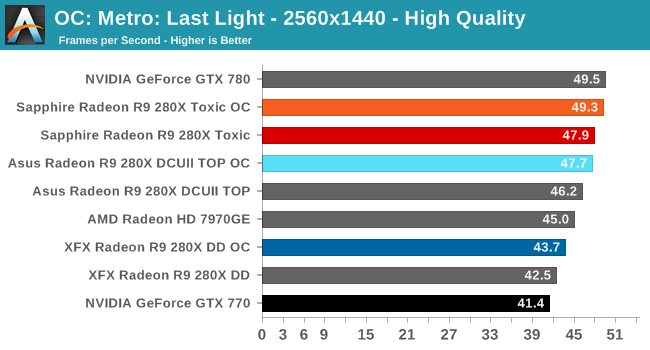
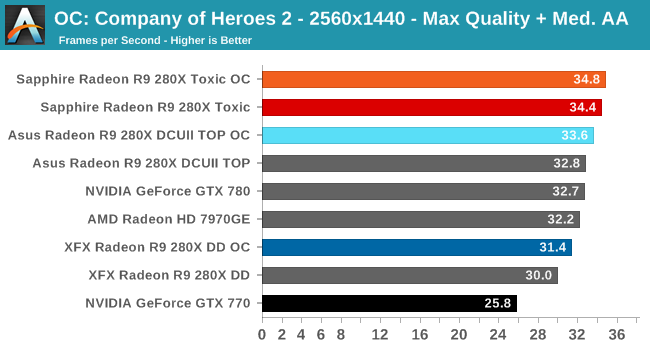
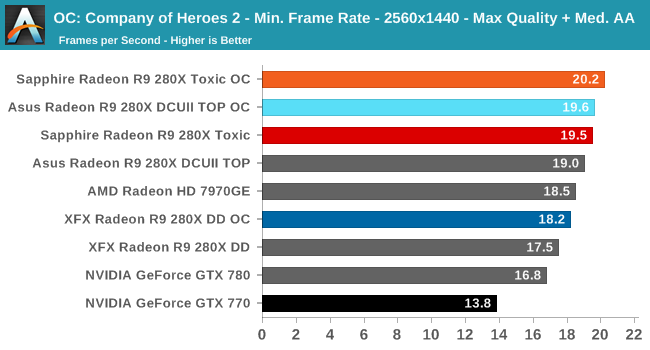
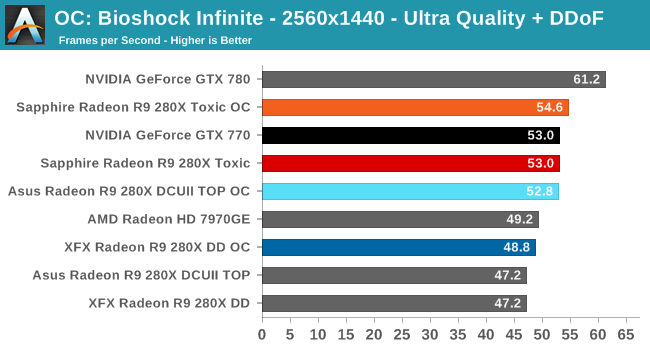
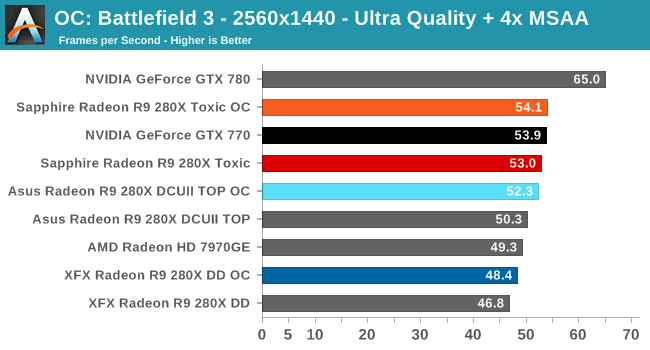

Despite the lack of gains from overclocking, the 280X Toxic is still the fastest 280X card even at stock. Our second best overclocking 280X is the Asus card, which topping out at a boost clock of 1110MHz still falls short of what the Toxic can achieve, and that was after supplying the Asus card with additional voltage. Undoubtedly some 280X cards with voltage adjustment will do better, but our results do paint a very convincing picture for just running the 280X Toxic at stock and ignoring all other cards, with or without overclocking.
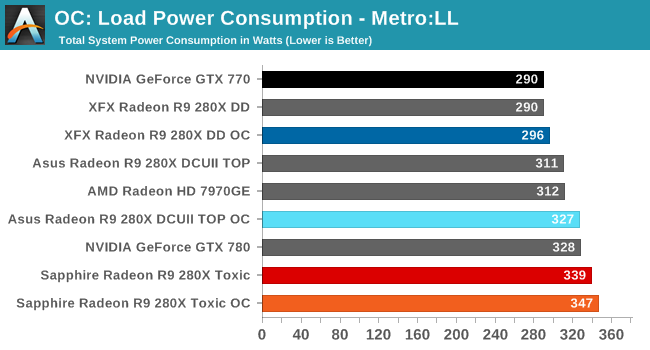
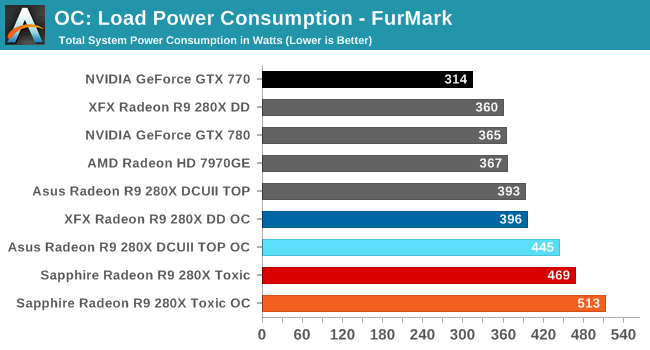
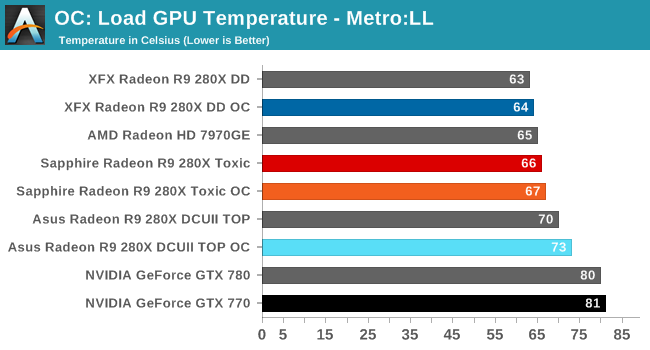

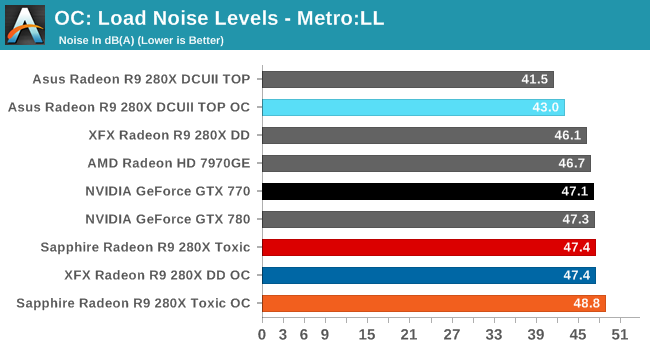
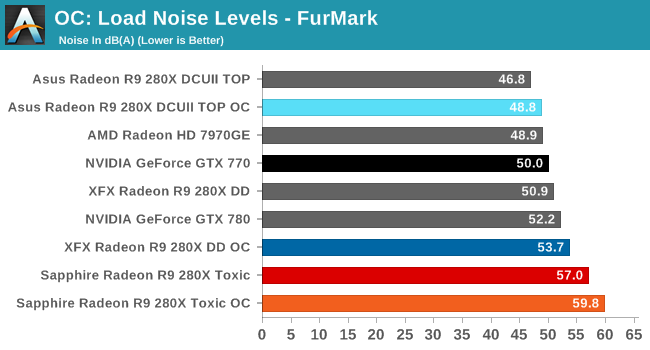
Since we can’t increase the GPU clock or the voltage of the 280X Toxic, the power/temp/noise hit is immaterial under Metro and other gaming workloads. You get almost nothing extra in performance for almost nothing extra in power/temp/noise. With our overclocked results thrown into the mix we can also see that while the stock 280X Toxic outperforms even our overclocked Asus 280X in gaming performance, it also does so while drawing more power than said overclocked Asus card. Clearly nothing is free here; more performance will cause a notable increase in power consumption.
Moving on to FurMark, with that 20% PowerTune increase FurMark absolutely goes nuts. 519W at the wall off of a single card is well out there, and the cooling performance also reflects this. This is all the more reason to leave the 280X Toxic at stock.










84 Comments
View All Comments
truprecht - Thursday, October 10, 2013 - link
No, it's clear the Titan should cost less.nathanddrews - Thursday, October 10, 2013 - link
I meant more expensive than the 280X.ShieTar - Thursday, October 10, 2013 - link
Well, nobody who was looking for a good price-performance ratio was choosing the 780 over a 770 anyways, so the 280X really does not change anything here. Let's wait for the 290X and see what happens to the pricing of the 780 and the Titan then.Impulses - Thursday, October 10, 2013 - link
NV said they had no plans to drop the 770's price, I would think a 780 drop is even less probable unless 290X just trounces it... Heck the 280X mostly matches or outperforms the 770 and it's $100 less!I'd been thinking of going NV for my next upgrade (from 2x 6950s), but if AMD can come thru with their frame pacing driver update for Eyefinity in November I'll probably choose AMD again.
EF seems more flexible than Surround anyway, software-config wise.
HisDivineOrder - Thursday, October 10, 2013 - link
nVidia won't admit they're going to do a price drop until they are DOING a price drop. Saying, "Yeah, we're gonna do one. In a few weeks. You know. Once we sell as many GPU's before we have to drop," seems like it'd be stupid to say.just4U - Saturday, October 12, 2013 - link
I really don't know what to make of any of this.. when Nvidia's high end 6x series came out it widely accepted as beating out the 7950-70 yet somehow or another Amd caught up. Than along comes Nvidia's high end 7x series and the 7970GHZ manages to kinda sort of keep pace. Than we have these new cards which are based loosely on the those cards and at stock their coming very close to... I think Anand said within 5% or so. That tells me that there isn't really a huge difference so it will be interesting to see what comes out of amd with their top end cards.It's clear there's no night/day difference so far.. anyone with a good card in the last year and a bit is sort of set for now.
adamantinepiggy - Thursday, October 10, 2013 - link
The article lists this as having "two" dual-link DVI ports. As far as I'm aware, none of the current ATI model video cards have "two" dual-link DVI ports, and issue I ran into when I wanted to drive two big cheap Korean Shimian 2560x1440 monitors that only come with dual link DVI inputs.adamantinepiggy - Thursday, October 10, 2013 - link
Oops, meant AMD video cards, but still think have ATI brand embedded in brain.Ryan Smith - Thursday, October 10, 2013 - link
It's a bit confusing. They're always physically DL-DVI ports; but electrically you're right, they can only drive 1 DL-DVI monitor. I'll go amend that to try to clarify it.commissar0617 - Saturday, October 12, 2013 - link
newegg says 2x dual-link. adamantine is wrong.